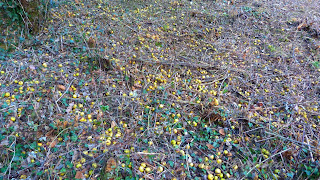This year I combine my job as nature and cultural guided, with the cleaning of Santiago´s way,where sometimes I work as guide in English.
When in the last year I did the way with a group of 15 English people, from Donibane Garazi (Saint Jean de Pied de Port) to Logroño, I didn´t realized it was particularly dirty, but when you start looking, you realizes all the garbage that people have thrown, or the paper that flew, that jacket that somebody left ... the two tents that have collected .. but above all, the most garbage was from paper napkins and wet wipes
Paper napkins are broken down over the years, and although they are biodegradable, they are biodesagreables like banana and tangerines peels, etc ..
 |
| Tent and waste, before arrive to Uterga (Navarre) |
 |
| After magnesitas factory (Zubiri,Navarre) |
However, the wet wipes are made from a stronger material, and do not decompose easily. Avoid leaving them in nature, please.
 |
| Pine trees between Bargota and Viana (Navarre) |
 |
| Shitter with underpants to bottom branches. |
 |
| Before arrives to Lintzoain |
I found all kinds of clothes, and I mean both jackets, shirts, rain jackets and pants, and socks, underpants, knickers or thongs, and I can not understand the reason to leave these clothes in the way, as it seems difficult to forget or lose.
I have filled about 50 garbage bags (100 liters) and without big things like car wheels or big plastic bottles that I do not put them in the bags.
It is also true that on the periphery of the villages, I collected a lot of trash that it was clear not correspond to pilgrims but to the villagers, or weekenders and bunches of youngers will drink in areas where they could access the cars.
 |
| Waste collected from the cross with the road to Bargota until Viana ( Navarre) |
They can pass through a path 1000 clean people and not be noticed thar they are passed, but 10 dirty people passin everything looks like a rubbish tip.
Anyway, if every year each year pass more than 200,000 pilgrims from 150 countries, there must be clean people and dirty people, as in all the countries.
I understand that if someone has a stomach crump on the path, and no bathrooms nearby, have to get by on a secluded side of the way in a pine forest, among the brambles, etc .. but consider how you leave the place after you.
If we want to do things right, the best is to make a hole in the ground, or to use a natural one, and then cover it with leaves or soil so that it rots quickly.
The alternative to using paper is to use the water bottle that all pilgrims have to cleanse the bottom. IWhen I was child, all of us used trees leaves, although I prefer the alternative of the water.
Whatever that thousands of people do in a small space has a big impact. There is no culture that likes the trash, but all of them have it, and the treatment is very different, well as their level of involvement in its elimination.
The idea will be that everyone should have about the garbage is that if we have brought here, we should continue taking it until throw in the containers.













































